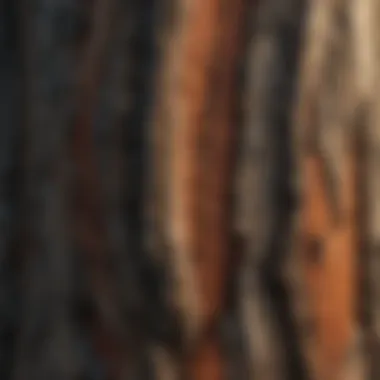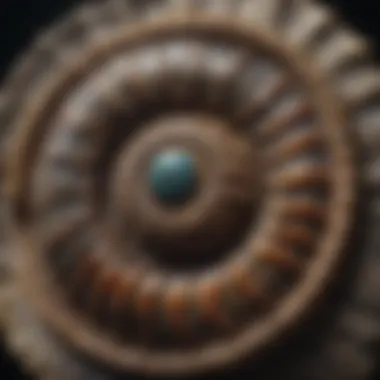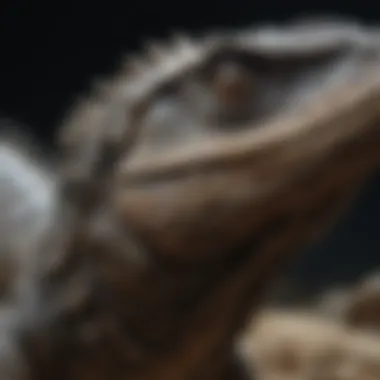Unveiling the Fascinating Fossil Marvels of South Africa


Rock and Fossil Identification
Delving into the world of South Africa's fossil wonders brings us to the intricate realm of rock and fossil identification. For rock enthusiasts and fossil collectors alike, understanding the types of rocks and fossils prevalent in this region is paramount. South Africa boasts a diverse array of fossil specimens ranging from ancient hominid remains to remarkably preserved marine fossils. When identifying these treasures, key characteristics such as texture, color, and embedded fossils serve as crucial markers. Enthusiasts often utilize tools like magnifying glasses, chisels, and brushes to carefully examine and uncover the hidden details within each specimen.
Collecting Tips and Techniques
Preservation and Display
Preservation forms an essential aspect of the journey into South Africa's fossil wonders, ensuring that these ancient relics are safeguarded for generations to come. Techniques such as cleaning, stabilizing, and consolidating fossils help maintain their pristine condition. Proper storage methods involve utilizing acid-free materials, controlled humidity levels, and adequate support structures to prevent deterioration over time. When it comes to creative display ideas, enthusiasts often curate their collections in thematic arrangements, custom-designed shelving units, or even professional exhibition spaces to showcase the magnificence of these fossil wonders.
Geological Insights
Venturing into the geological insights of South Africa unveils a fascinating narrative of historical significance, geological formations, and notable discoveries. The region's varied landscapes showcase a spectrum of geological formations, from ancient Precambrian rocks to more recent sedimentary layers, each revealing a chapter in Earth's evolving story. The historical significance of the rocks and fossils found in South Africa transcends mere scientific curiosity, offering insights into ancient ecosystems, climate patterns, and evolutionary developments. Notable discoveries such as the Taung Child, Australopithecus fossils, and fossilized marine life continue to shape our understanding of the deep past, highlighting the immense value of South Africa's fossil wonders to the field of paleontology.
Explore the marvels of South Africa's fossil heritage, where every rock and fossil holds a story waiting to be unearthed.
Introduction to South Africa's Fossil Heritage
The topic of 'Introduction to South Africa's Fossil Heritage' forms the foundation of this enlightening article. South Africa boasts a remarkable fossil heritage that provides a window into the past, offering insights into the evolution of life on Earth. This section serves as an entry point into the wondrous world of prehistoric treasures found in this diverse region. By understanding South Africa's fossil heritage, readers are beckoned to embark on a captivating journey through time, exploring the rich tapestry of ancient life forms that once roamed the land. Through meticulous research and exploration, scientists have unearthed a myriad of fossil specimens that shed light on the evolutionary trajectories of various organisms. The exploration of South Africa's fossil heritage unveils a treasure trove of information that not only informs our understanding of the past but also helps shape our perspectives on the present and future of life on Earth.
A Brief Overview of South Africa's Geology
Delving into the geological underpinnings of South Africa, one encounters a complex mosaic of rock formations that have preserved a diverse array of fossils over millions of years. The country's geology plays a fundamental role in the fossilization process, creating conducive environments for the preservation of ancient remains. From the sedimentary layers of the Karoo Basin to the limestone deposits of the Cradle of Humankind, South Africa's geological diversity has yielded invaluable insights into the plants and animals that once inhabited these lands. Understanding the geological context of fossil discoveries is crucial in piecing together the puzzle of prehistoric life, painting a vivid picture of the landscapes that existed eons ago.
Significance of Fossils in Understanding Evolution
Fossils serve as invaluable clues that allow scientists to reconstruct the evolutionary history of life on Earth. In South Africa, fossils offer a glimpse into ancient ecosystems and the organisms that populated them, providing a tangible link to our biological past. By studying these fossilized remains, researchers can trace the lineage of species, uncover transitional forms, and elucidate key evolutionary transitions. The significance of fossils in understanding evolution extends beyond mere academic curiosity; it deepens our appreciation for the interconnectedness of all life forms and highlights the dynamic processes that have shaped biodiversity over millennia.
Exploring the Paleontological Landscape
The paleontological landscape of South Africa is a vast terrain dotted with sites of paleontological significance. From the iconic fossil-bearing caves of the Cradle of Humankind to the fossil-rich deposits of the Karoo Basin, this country offers a plethora of treasures waiting to be unearthed. Each excavation reveals a piece of the puzzle, contributing to our collective understanding of the biological history of the region. By exploring the paleontological landscape, researchers gain insights into past climates, ecosystems, and evolutionary trends, painting a comprehensive picture of life's evolutionary journey. This section invites readers to wander through the fossiliferous plains of South Africa, where every fossil tells a story and every discovery opens a new chapter in the annals of paleontology.
Fossil Discoveries in South Africa


South Africa's fossil discoveries hold a paramount significance within the realm of paleontology, offering a captivating glimpse into the prehistoric world that once thrived in this region. These discoveries not only shed light on the evolutionary trajectories of various species but also provide invaluable insights into the environmental conditions of the past. By delving into the fossil record of South Africa, researchers and enthusiasts alike can unearth a treasure trove of information that informs our understanding of ancient life forms and ecosystems.
The Cradle of Humankind: Hominid Fossils
Taung Child: A Landmark Discovery
The discovery of the Taung Child remains a pivotal moment in paleontological history, unveiling a fossilized hominid skull that revolutionized our perceptions of human evolution. This landmark discovery, dating back millions of years, offers a tangible link to our ancestral past, providing researchers with a unique opportunity to study early hominid morphology and behavior. The Taung Child's fossilized remains present a rare glimpse into the developmental stages of our human lineage, offering invaluable insights into the adaptation and survival strategies of early hominids.
Mrs. Ples: Unraveling Human Origins
Mrs. Ples, another iconic fossil discovery in South Africa, has played a crucial role in unraveling the mysteries surrounding human origins. Through the study of Mrs. Ples' skull and skeletal remains, researchers have been able to reconstruct aspects of our ancestral heritage, shedding light on the anatomical features and evolutionary pathways that distinguish us as a species. Mrs. Ples stands as a testament to the rich fossil diversity found in South Africa and continues to be a focal point for studying the nuances of human evolution.
Diverse Fauna: Mega-Fauna Fossils
Giant Ground Sloth: An Ice Age Survivor
The presence of the Giant Ground Sloth fossils in South Africa provides a fascinating glimpse into the megafauna that roamed the region during the Ice Age. These colossal creatures, with their unique adaptations to a changing environment, offer researchers valuable insights into the dynamics of prehistoric ecosystems and the interplay between large herbivores and their surroundings. The Giant Ground Sloth's fossilized remains serve as a testament to the evolutionary strategies that enabled certain species to thrive in challenging climatic conditions.
Smilodon: The Iconic Saber-Toothed Cat
The discovery of Smilodon fossils represents a cornerstone in our understanding of prehistoric predators and their impact on ancient ecosystems. As one of the most iconic saber-toothed cats of the Pleistocene era, Smilodon's fossil record grants researchers a window into the predatory behaviors and ecological interactions of these formidable carnivores. By studying the Smilodon fossils found in South Africa, paleontologists can piece together the intricate food webs and trophic dynamics that shaped the ancient landscapes of the region.
Marine Marvels: Fossilized Sea Creatures
Ichthyosaur Fossils: Ancient Marine Reptiles
The presence of Ichthyosaur fossils in South Africa unveils a mesmerizing world of ancient marine reptiles that once inhabited the prehistoric oceans. These well-preserved remains provide researchers with a rare opportunity to reconstruct the anatomies and behaviors of these marine giants, offering insights into their evolutionary adaptations and ecological roles. The Ichthyosaur fossils stand as testament to the diverse marine life that thrived in the ancient seas around South Africa, showcasing the rich biodiversity that characterized prehistoric aquatic ecosystems.
Ammonites: Spiraled Treasures of the Sea
The fossilized Ammonites found in South Africa serve as exquisite examples of the intricate shell structures created by these ancient cephalopods. These spiraled treasures of the sea offer a window into the past, allowing researchers to explore the evolutionary history and ecological significance of these mollusks. The study of Ammonite fossils in South Africa provides valuable information on past oceanic environments, contributing to our understanding of marine biodiversity and the intricate interconnections that shaped ancient seascapes.
Paleontological Sites and Museums


In the exploration of South Africa's rich fossil heritage, Paleontological Sites and Museums play a vital role in preserving and showcasing the country's prehistoric treasures. These sites serve as educational hubs and conservation centers, offering visitors a glimpse into the ancient past while highlighting the significance of fossil preservation. The Cradle of Humankind World Heritage Site, Robben Island Museum, and Iziko South African Museum stand out as prominent locations where fossil wonders are not only preserved but also presented to the public for admiration and research purposes. Each location holds a unique collection of fossils and exhibits, contributing to the overall understanding of South Africa's extraordinary fossil record.
A Visit to the Cradle of Humankind World Heritage Site
Embarking on a journey to the Cradle of Humankind World Heritage Site is a transcendental experience, immersing visitors in a landscape rich with historical significance. This iconic site, located just outside Johannesburg, is home to some of the world's most famous hominid fossils, providing a glimpse into our evolutionary past. The interactive exhibits and guided tours offer a comprehensive look at the importance of this site in unraveling the mysteries of human evolution. Stepping into the Cradle of Humankind is not just a visit to a tourist attraction but a profound exploration of our shared history as a species.
Robben Island Museum: Tracing Fossilized Footprints
Tracing fossilized footprints at the Robben Island Museum unveils a poignant blend of natural history and human struggle. This museum, known for its historical significance as a former political prison, also houses a collection of fossil imprints that highlight the presence of ancient creatures in what is now an emblem of resilience and freedom. The juxtaposition of fossil footprints against the backdrop of a turbulent past adds a layer of complexity to the narrative of South Africa's fossil wonders. Visitors are invited to contemplate the interconnectedness of life forms across time and the enduring spirit of survival.
Iziko South African Museum: Showcasing Fossil Diversity
The Iziko South African Museum stands as a beacon of fossil diversity, showcasing a plethora of ancient species that once roamed the South African landscapes. From mesmerizing marine fossils to impressive skeletal reconstructions, this museum offers a comprehensive overview of the country's prehistoric past. Visitors can marvel at the intricate details preserved in fossils and gain a deeper understanding of the evolution of life on Earth. The museum's commitment to education and research ensures that these fossil wonders continue to inspire and inform future generations of scientists, fossil enthusiasts, and curious minds.
Preservation and Conservation Efforts
Preservation and Conservation Efforts are pivotal in the discourse of South Africa's Fossil Wonders, safeguarding invaluable paleontological heritage for future generations. This section delves into the multifaceted importance of proactive measures aimed at sustaining the integrity of fossil sites. By meticulously preserving these sites, researchers can continue unraveling the mysteries of the past while presenting a window into the evolutionary history deeply embedded in South Africa's soil.
Challenges in Preserving Fossil Sites
Maintaining the integrity of fossil sites presents a myriad of challenges, ranging from natural erosion and geological shifts to human interference. The delicate nature of fossils requires meticulous care during excavation and transport to prevent damage or loss. Ensuring the longevity of these sites demands constant vigilance and expertise, marking a crucial aspect in safeguarding these irreplaceable treasures embedded in South Africa's geological landscape.
Impact of Climate Change on Fossil Preservation
Climate change poses a poignant threat to fossil preservation, altering environmental conditions crucial for maintaining the integrity of ancient remains. The shifting climate patterns can accelerate erosion, expose previously buried fossils to the elements, and disrupt delicate ecosystems where fossil sites reside. Understanding the implications of climate change on fossil preservation is essential for implementing adaptive strategies to mitigate potential losses in South Africa's unique paleontological record.
Community Involvement in Protecting Fossil Heritage
Engaging local communities and stakeholders plays a pivotal role in preserving South Africa's fossil heritage. By fostering awareness and responsibility among residents, conservation efforts can gain momentum, ensuring the sustainable management of fossil sites. Community involvement not only safeguards these treasures but also fosters a sense of pride and ownership, cultivating a collective commitment to safeguarding South Africa's rich paleontological legacy.
Future Prospects and Research Directions
Future prospects and research directions play a vital role in shaping the trajectory of paleontological studies, offering a glimpse into the innovative techniques and discoveries anticipated in the coming years. By focusing on these specific elements, we aim to provide a comprehensive overview of the evolving landscape of fossil research in South Africa and its impact on the global scientific community.


Moreover, by discussing the benefits associated with future prospects and research directions, we highlight how these advancements can lead to enhanced understanding of prehistoric life, evolution, and geological phenomena. Through a careful evaluation of the considerations surrounding this topic, we aim to underscore the complex nature of paleontological investigations and the multifaceted approaches required to navigate this intriguing field successfully.
Innovations in Fossil Analysis Techniques
In the arena of paleontology, innovations in fossil analysis techniques represent a cornerstone of scientific progress and discovery. This section hones in on the cutting-edge methods employed by researchers to dissect, analyze, and interpret fossil specimens with unprecedented precision and detail.
By delving into the intricate world of technological advancements, we uncover how state-of-the-art tools such as scanning electron microscopes, computed tomography imaging, and isotopic analysis revolutionize the way fossils are studied. These innovations not only provide deeper insights into the biology, morphology, and ecology of ancient organisms but also push the boundaries of paleontological research to new heights.
Emerging Discoveries in South African Paleontology
The landscape of South African paleontology is constantly evolving, giving rise to a myriad of exciting discoveries that reshape our understanding of the distant past. This section focuses on the latest breakthroughs in the field, from the unearthing of new fossil species to the reinterpretation of existing data, and explores the implications of these emerging findings.
By delving into these discoveries, we illuminate how South Africa continues to be a hotbed of paleontological activity, attracting researchers from around the globe to unravel its fossil mysteries. From the identification of previously unknown species to the discovery of fossilized behaviors, each finding adds a new layer of complexity to the rich tapestry of South Africa's paleontological heritage.
Collaborative Projects for Fossil Research Advancement
Collaboration lies at the heart of advancing fossil research in South Africa, with interdisciplinary projects fostering innovation, sharing of expertise, and mutual exploration. This section highlights the importance of collaborative endeavors in paleontology, showcasing how joint efforts among scientists, institutions, and communities propel the field forward.
By discussing collaborative projects that span across disciplines and borders, we showcase the power of collective knowledge and resources in unlocking the secrets held within South Africa's fossil landscapes. Through synergistic partnerships and shared research goals, these initiatives not only enrich our understanding of prehistoric life but also pave the way for future discoveries that transcend traditional boundaries of scientific inquiry.
Conclusion: Unraveling the Mysteries of South Africa's Fossil Legacy
As we unpack the layers of South Africa's fossil record, we encounter a tapestry of stories etched in stone, each fragment a piece of the puzzle that enriches our understanding of the planet's geological and biological history. The Cradle of Humankind stands out as a beacon of human ancestry, where the discovery of hominid fossils like the Taung Child and Mrs. Ples has reshaped our understanding of evolution and origins. These remarkable finds underscore the importance of preserving and studying fossils, as they hold the keys to unlocking the mysteries of our past and shaping our future.
Moreover, the marine marvels found in South Africa's fossil record, such as the fossilized sea creatures like Ichthyosaurs and Ammonites, offer a glimpse into primordial oceans teeming with exotic life forms. These fossils not only captivate us with their intricate details but also inspire awe and wonder at the diversity of life that once flourished in ancient seas. By unraveling the secrets hidden within these fossil treasures, we unravel the tapestry of life itself, piecing together the puzzle of our planet's ecological evolution.
Through collaborative efforts, innovative research, and a deep-seated passion for discovery, the mysteries of South Africa's fossil legacy continue to unfold before us, beckoning future generations to delve deeper into the annals of time. The journey of unraveling these ancient mysteries is far from over, as each fossil holds a story waiting to be told, a revelation waiting to be unearthed. As we conclude this exploration, we are reminded that the legacy of South Africa's fossils is not just a chapter in the history of paleontology but a testament to the resilience, diversity, and beauty of life itself.
Reflecting on the Palaeontological Riches of South Africa
In reflecting on the palaeontological riches of South Africa, one cannot help but be humbled by the sheer abundance and diversity of fossils that have been discovered in this land of ancient wonders. From the preserved remains of our hominid ancestors to the fossilized traces of long-extinct mega-fauna, each find paints a vivid picture of the rich tapestry of life that once thrived in these landscapes. The significance of these fossil treasures extends beyond mere scientific curiosity; they offer a tangible link to our shared past and a deeper understanding of our place in the grand narrative of evolution.
The exploration of South Africa's palaeontological sites not only reveals the intricate patterns of life that shaped our planet but also highlights the fragility and resilience of ecosystems over millennia. By studying these fossils, researchers and enthusiasts alike gain insights into the adaptive strategies of ancient species, the impact of environmental changes on biodiversity, and the interconnectedness of life forms across geological time scales. Each fossil unearthed is a window into a world long gone, a testament to the enduring legacy of life on Earth.
Inspiring the Next Generation of Fossil Enthusiasts
As we look towards the future, it becomes evident that inspiring the next generation of fossil enthusiasts is paramount to continuing the legacy of exploration and discovery that defines palaeontology. By engaging young minds in the wonders of South Africa's fossil record, we kindle a curiosity and passion for the natural world that transcends boundaries and fosters a deep appreciation for the magnificence of life's history. Encouraging students to pursue careers in palaeontology not only ensures the continuity of scientific research but also nurtures a sense of stewardship towards our planet's invaluable fossil heritage.
Through educational outreach programs, interactive museum exhibits, and hands-on field experiences, we can instill in the youth a sense of wonder and awe for the treasures that lie beneath the Earth's surface. By immersing them in the world of fossils, we ignite a thirst for knowledge and a desire to uncover the mysteries that still lie hidden in the rocks and sediments of our planet. The future of palaeontology rests in the hands of those who are inspired to seek answers, ask questions, and embark on the journey of unraveling the fossil wonders that await discovery.







